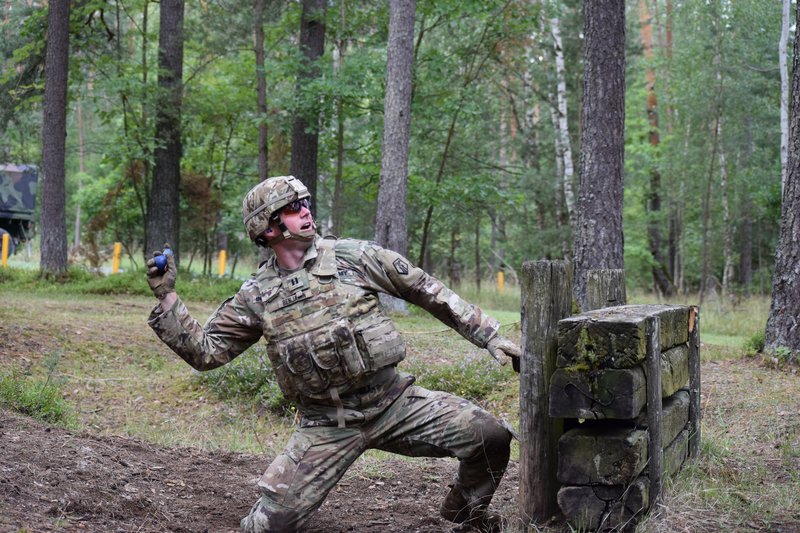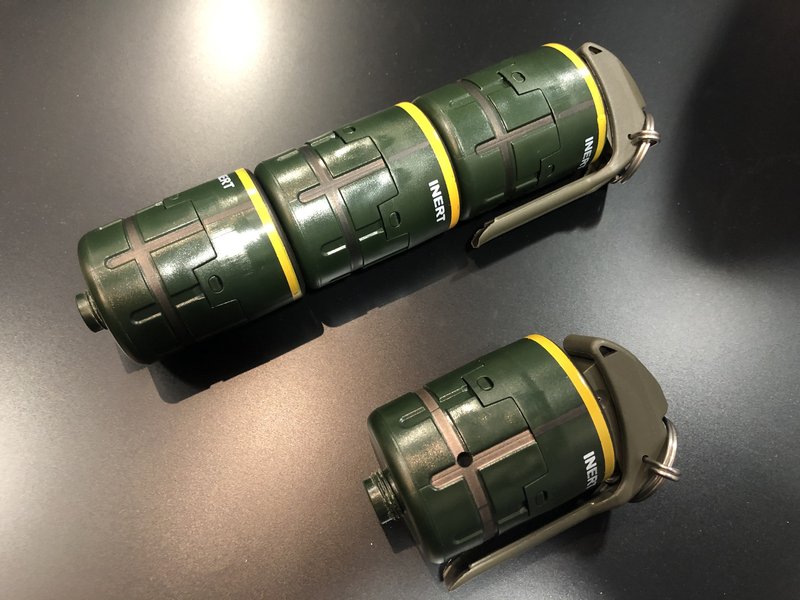Don’t forget the training requirement – new grenade programme highlights device demand
Early US fielding of Nammo’s Scalable Offensive Hand Grenade (SOHG) has highlighted the critical relationship between new systems and their supporting training devices.
Training hand grenades are traditionally designed to provide a low-cost, realistic and safer option for instructing soldiers in the proper use and handling of the actual weapon... Continues below
Newsletter Sponsors:

Above: Training grenades are typically blue in colour and use as many of the live weapon’s components as possible for greater realism. (Photo: US Army)
These training grenades typically use production parts and inert fill to match tactical grenades with the correct weight and balance. Training fuzes feature the same three to five second delay element plus a small pyrotechnical charge to produce a sound signal when thrown.
The most recent US training grenade was developed for Nammo’s SOHG, which utilises standard threaded modules that can be used in different configurations to allow the user to scale the effects during a mission.
According to Andy Davis, CTO of Nammo Defense Systems, the grenades were initially slated for fielding only to USSOCOM Tier 2 elements, but that has now been expanded to include USMC ‘frontline infantry units’.

MVRsimulation’s VRSG: bringing military simulation training to life.
‘We got the SOHG initially qualified about 2018,’ he said. ‘And, because it was qualified through NSWC [Naval Surface Warfare Center] Crane, the marine corps was able to get access to it. The marine corps then ended up writing a requirements document and now SOHG will become standard issue for marine corps infantry.’
Davis said that the first three USMC shipments had been completed as of mid-January this year, for a total of ‘just under 33,000 grenades’, with additional deliveries planned for 2025.
He stated that one factor that could impact delivery schedules involved development and fielding of an SOHG training grenade.
‘We had developed trainers in the past for grenades like our HGO225 but we had never developed one for our SOHG,’ he said. ‘But right before COVID, as we were moving down the path for qualifying the SOHG for Tier 2 USSOCOM, people started asking about a trainer. And our customer said that if we could provide sample SOHG training grenades, they would get them into users’ hands and on the qualification programme.’
But then the pandemic hit and the operational challenges surrounding that prevented the trainers from getting into users’ hands for more than two years.
In fact, it wasn’t until an International Special Operations Forces (ISOF) event in March 2023 that Davis had a chance to demonstrate the SOHG training grenades to USSOCOM representatives for the first time.

‘It was like everyone suddenly realised that they were getting ready to issue these grenades to the field but didn’t have a trainer yet,’ he explained, adding that the realisation helped accelerate contract modifications to qualify the training grenade.
The SOHG training grenade, which is light blue in colour, has the same 3.5-second fuze, same pull pin and same feel as the tactical SOHG.
‘The only difference is that these training modules are reusable,’ Davis said. ‘They have a steel insert and can be reused up to 50 times. All the user has to do is buy a trainer fuze, which is the disposable part that will function with every throw.’
He added that the development of the new training grenade did not take long, since the company was already fielding equivalents for its HGO225 and HGO115 grenades to Finland and Norway.

Above: Nammo’s SOHG is seen here in ‘base plus two’ configuration, with all three modules threaded together. (Photo: author)
‘So, when they went to go make an SOHG module, all they essentially did was use the same injection-moulded hardware and develop the steel insert. Because the moulds for the spoons also are the same, all they had to do was inject blue plastic instead of green plastic. So it was not really a technological hurdle to get these trainers made and to start the qualification process.’
Davis said that he went to Finland prior to his March 2023 demonstration for ISOF to practice throwing the SOHG trainers.
‘I’m very glad I went,’ he admitted. ‘I’ve thrown SOHGs many times before but I’ve never thrown a base plus two [a total of three modules screwed together]. And, as I showed the users, you absolutely need a trainer because when I pull this pin, and I go to throw it, I’ve got a physical mass [of additional modules] that’s hanging out [the side of my hand].
‘You can’t throw it like a baseball because the mass hanging out takes it right of your target [for a right-handed throw]. So every time I was trying to throw a “base plus two”, it was ending up right of where I wanted it to be. So when I went out to ISOF, I explained to these guys, “I just did this in Finland last week and here’s what I learned. Give it a try.”
‘And sure enough, they got up there and they were “winging them to the right”. And then it clicked that it would be a very good thing to have a trainer to practice with.’
Other articles in this newsletter:
Background checks – why vetting foreign military students is vital
Marines in the Philippines – putting bilateral exercises in the spotlight
Don't want to miss out on future Decisive Edge content? Make sure you are signed up to our email newsletters.












